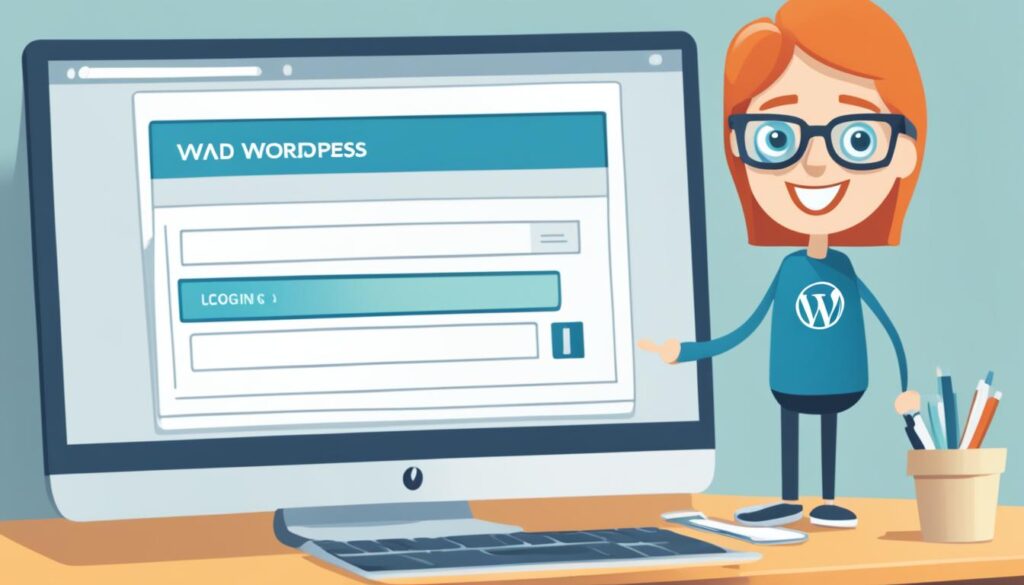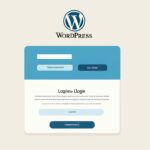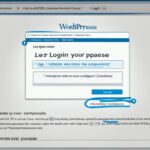Table of Contents
Welcome to our access guide on how to log into your WordPress website. Whether you’re a new website owner or a WordPress beginner, this comprehensive guide will provide you with step-by-step instructions to help you navigate the login process seamlessly. By the end of this guide, you’ll be able to effortlessly log into your WordPress website and access all its features.
Logging into your WordPress website is the first step in managing your online presence. With your login credentials, you’ll have access to the content management system that powers your website, allowing you to create, edit, and publish new content, customize your site’s appearance, and much more. Whether you want to start a blog or run a full-fledged e-commerce store, logging into your WordPress website is where your journey begins.
Key Takeaways:
- Logging into your WordPress website is essential to manage your online presence effectively.
- Your login credentials give you access to the content management system, allowing you to create and customize your website.
- Follow the step-by-step instructions in this guide to log into your WordPress website effortlessly.
- Always ensure the security of your login process by implementing strong passwords and other security measures.
- If you encounter any login issues, troubleshoot them using the tips provided in this guide or seek assistance from our support team.
Understanding the WordPress Login Page
Before you can log into your WordPress website, it’s essential to understand the WordPress login page. This page serves as the gateway to access the backend of your website and manage its content, design, and functionality.
Let’s take a closer look at the elements and features of the WordPress login page to familiarize yourself with its structure:
- Login Form: The login form is the core component of the WordPress login page. It consists of two fields: one for your username or email address and the other for your password. In this form, you will enter your login credentials to gain access to your website.
- Logo and Site Title: Depending on your website’s configuration, you may see your website’s logo and site title displayed on the login page. This branding element provides visual identification and reassurance to users that they are logging into the correct website.
- Lost Your Password Link: In case you forget your password, the WordPress login page includes a “Lost your password?” link. Clicking on this link will direct you to the password recovery page, where you can reset your password and regain access to your account.
- Error Messages: If you enter incorrect login credentials or encounter any login errors, the WordPress login page will display error messages to notify you of the issue. These messages are designed to guide you in resolving the login-related problems.
- Registered User Link: If you have already registered an account on the website, the WordPress login page may provide you with a link to directly access the user registration page. This link allows new users to create an account and gain access to additional features, if applicable.
By understanding the elements and features of the WordPress login page, you can easily locate the login form and complete the login process. Familiarizing yourself with these components will make the login process smoother and more efficient.
An informative and visually engaging table comparing the login pages of different content management systems can further enhance your understanding:
| Content Management System | Distinctive Features |
|---|---|
| WordPress | Intuitive interface with customizable branding elements |
| Drupal | Rigorous security features with granular permission settings |
| Joomla | User-friendly login form with optional two-factor authentication |
| Magento | Multiple store login functionality for seamless website management |
Understanding the WordPress login page is the first step towards successfully accessing your website’s backend. Now that you are familiar with the key components, let’s move on to the next section where we will guide you on how to locate the WordPress login URL.
Locating the WordPress Login URL
Finding the WordPress login URL may seem daunting for first-time users. In this section, we will provide you with various methods to locate the WordPress login URL, ensuring you can access your website’s login page with ease.
If you’re using a standard WordPress installation, the login URL can be accessed by simply adding /wp-login.php or /wp-admin to your website’s domain name. For example, if your domain is www.yourwebsite.com, the login URL would be www.yourwebsite.com/wp-login.php or www.yourwebsite.com/wp-admin.
Alternatively, if you have changed the default login URL for security purposes, you can try the following methods to find the updated login URL:
1. Check your email
When you first set up your WordPress website, you may have received an email containing your login credentials and the login URL. Search your email inbox for any emails from your hosting provider or WordPress installation.
2. Use the admin bar
If you are already logged into your WordPress dashboard, you can find the login URL in the admin bar at the top of your website. Look for the “Howdy, [Your Username]” message and click on it, then select “Logout” from the dropdown menu. The login URL will be visible in the address bar of your browser.
3. View the source code
If you have access to the source code of your WordPress website, you can locate the login URL by viewing the source code. Right-click anywhere on your website, select “View Page Source” or “Inspect Element,” and search for wp-login.php or wp-admin. The login URL will be displayed in the HTML code.
By using these methods, you will be able to easily locate the WordPress login URL and gain access to your website’s login page.

| Method | Steps |
|---|---|
| Check your email | Search your inbox for any emails containing your login credentials or the WordPress login URL. |
| Use the admin bar | If you are already logged in, click on your username in the admin bar and select “Logout” to view the login URL in the address bar. |
| View the source code | If you have access to the source code, right-click on your website and select “View Page Source” or “Inspect Element” to search for the login URL in the HTML code. |
Logging into Your WordPress Website
Now that you have located the WordPress login URL, it’s time to log into your website and start managing your content. Follow the step-by-step guide below to ensure a successful login:
Step 1: Enter your WordPress login credentials
On the WordPress login page, you will see two text boxes labeled “Username” and “Password.” Enter your registered username and password in the respective fields.
If you’re unsure about your login credentials, reach out to your website administrator or refer to the account creation email you received when setting up your WordPress website.
Step 2: Complete the login process
After entering your username and password, click on the “Log In” button or press the Enter key on your keyboard. WordPress will validate your credentials and log you into the administrative dashboard.
If you have entered the correct details, you will be redirected to the dashboard, where you can start managing your website’s content, installing plugins, customizing themes, and more.
If you encounter any errors during the login process, double-check your username and password for accuracy. Remember that both fields are case-sensitive, so ensure that your input matches the exact capitalization of your login details.
Pro Tip: If you frequently access your WordPress website, you can check the “Remember Me” option before clicking “Log In.” This will save your login credentials on your device for quicker access in the future. However, avoid using this feature on public or shared devices to maintain the security of your website.
Once you have successfully logged in, you will be greeted with the WordPress dashboard – a central hub for managing your website’s content and settings. Familiarize yourself with the various sections and navigation menus on the dashboard to make the most out of your WordPress experience.
Take your time to explore the dashboard and its features. If you need assistance or want to learn more about a specific function, refer to the WordPress documentation or reach out to the WordPress community for support.
Now that you have successfully logged into your WordPress website, you can start creating, publishing, and managing your content with ease.
Next, let’s explore common troubleshooting tips for login issues in Section 5.
Troubleshooting Login Issues
Sometimes, you may encounter login issues or have trouble accessing your WordPress website. Don’t worry, we’re here to help! In this section, we will cover common login problems and provide troubleshooting tips to help you overcome any obstacles you may face.
Common Login Problems
When it comes to logging into your WordPress website, there are a few common issues that users may encounter. Let’s take a look at some of them:
- Forgotten Password: Have you forgotten your password? It happens to the best of us. Fortunately, WordPress provides a simple password recovery process that allows you to reset your password and regain access to your website.
- Incorrect Username or Password: Double-check that you are entering the correct username and password combination. It’s easy to make a typo or mistake, so take a moment to ensure you’ve entered the right credentials.
- Locked Account: If you’ve entered the wrong password multiple times, your account may be temporarily locked. In this case, you can use the password recovery process or contact your website administrator for assistance.
- Browser Issues: Certain browser settings or extensions can sometimes interfere with the login process. Clearing your browser cache or trying a different browser can help resolve this problem.
Troubleshooting Tips
Now that you’re aware of some common login problems, here are some troubleshooting tips to get you back into your WordPress website:
- Reset Password: If you’ve forgotten your password, click on the “Forgot Password” link on the login page. Follow the instructions to reset your password and regain access to your website.
- Double-Check Credentials: Ensure that you are entering the correct username and password combination. Pay attention to uppercase and lowercase letters, as WordPress is case-sensitive.
- Contact Website Administrator: If you’re still unable to log in after resetting your password and double-checking your credentials, reach out to your website administrator for further assistance. They will be able to investigate and help resolve any login issues.
- Disable Browser Extensions: If you suspect that browser extensions are causing login problems, try disabling them temporarily. This can help identify if any specific extension is interfering with the login process.
By following these troubleshooting tips, you should be able to resolve most login issues you may encounter. If you continue to experience problems, don’t hesitate to seek further assistance from your website administrator or support team.
| Problem | Troubleshooting Steps |
|---|---|
| Forgotten Password | Use the password recovery process to reset your password. |
| Incorrect Username or Password | Double-check that you are entering the correct credentials. |
| Locked Account | Try the password recovery process or contact your website administrator. |
| Browser Issues | Clear your browser cache or try a different browser. |
Remember, troubleshooting login issues is a normal part of website management. By following the steps outlined here, you’ll be able to overcome common problems and regain access to your WordPress website effortlessly.
Securing Your WordPress Login
Protecting your WordPress login is crucial for the security of your website. In this section, we will explore various measures you can take to enhance the security of your login process and safeguard your website from unauthorized access.
Implement Strong Passwords
One of the fundamental steps in securing your WordPress login is to use strong, unique passwords. Avoid common passwords such as “123456” or “password” and instead create complex combinations of uppercase letters, lowercase letters, numbers, and special characters. Additionally, consider using a password manager to generate and securely store your passwords.
Enable Two-Factor Authentication
Two-factor authentication (2FA) adds an additional layer of security to your WordPress login. By enabling 2FA, you will be required to provide a second form of verification, such as a unique code sent to your mobile device, in addition to your password. This prevents unauthorized access even if your password is compromised.
Use Security Plugins
Another effective way to secure your WordPress login is to install and configure security plugins. These plugins offer features such as login lockdown, IP whitelisting, and brute-force protection, which help detect and block suspicious login attempts. Popular security plugins include Wordfence, Sucuri, and iThemes Security.
By implementing these measures, you can significantly improve the security of your WordPress login and protect your website from potential threats and unauthorized access.
Logging out of Your WordPress Website
Once you have finished working on your WordPress website, it is essential to log out to ensure the security of your site and protect your user account. The logout process is simple and can be done in just a few steps. Here’s how you can log out of your WordPress website:
-
Step 1: Access your WordPress admin dashboard.
To log out of your WordPress website, you first need to access your admin dashboard. This is typically done by appending “/wp-admin” to your website’s URL (e.g., www.yourwebsite.com/wp-admin).
-
Step 2: Locate the logout option.
Once you are logged in, you will see a toolbar at the top of the screen. Look for the “Howdy, [your username]” greeting on the toolbar. Click on it to reveal a dropdown menu.
In the dropdown menu, you will find the “Log Out” option. Click on it to proceed with the logout process.
-
Step 3: Confirm your logout.
After clicking on the “Log Out” option, WordPress will ask you to confirm that you want to log out. This additional step ensures that you don’t accidentally log out of your website.
Click “Log Out” again to confirm and log out of your WordPress website.
Remember, it is important to log out of your WordPress website, especially when using shared or public computers. By logging out, you prevent unauthorized access to your site and protect your sensitive information.
By following these steps, you can easily log out of your WordPress website and maintain the security of your online presence.
| Benefits of Logging Out | Actions to Take |
|---|---|
| Prevents unauthorized access to your website | Regularly log out after each session |
| Protects your user account | Enable two-factor authentication for enhanced security |
| Safeguards sensitive information | Clear browser cache and history after logging out |
Conclusion
Now that you have mastered the art of logging into your WordPress website, you can confidently access your admin dashboard and take control of your online presence. By following the step-by-step instructions provided in this guide, you have gained the knowledge to navigate the login process effortlessly and ensure the security of your website.
Remember, if you ever encounter any difficulties or have further questions, our dedicated support team is always here to assist you. Don’t hesitate to reach out to us for any assistance you may need. We are committed to helping you succeed in your WordPress journey.
With a secure login in place, you can focus on managing your content, customizing your website, and engaging with your audience. Utilize the power of WordPress to its fullest potential, and watch your website flourish in the online world.
FAQ
How do I log into my WordPress website?
To log into your WordPress website, follow these steps:
1. Open your preferred web browser
2. Type in your website’s URL in the address bar
3. Add “/wp-admin” or “/login” at the end of the URL
4. Press Enter or Return on your keyboard
5. You will be redirected to the WordPress login page
6. Enter your username or email address in the “Username” field
7. Enter your password in the “Password” field
8. Click on the “Log In” button
9. You will be logged into your WordPress website and directed to the admin dashboard.
What is the WordPress login page?
The WordPress login page is the portal where you can access the backend of your website. It is where website owners and administrators can log in to manage their website’s content, design, and settings. The login page typically requires a username or email address and a password for authentication.
How can I find the WordPress login URL?
There are a few different ways to locate the WordPress login URL:
1. The default login URL for most WordPress websites is “yoursite.com/wp-admin”
2. If the default URL does not work, you can try “yoursite.com/admin” or “yoursite.com/wp-login.php”
3. If you have a custom login URL set up, refer to the instructions provided by your website administrator.
How do I troubleshoot login issues with WordPress?
If you are experiencing login problems with your WordPress website, try these troubleshooting steps:
1. Double-check that you are entering the correct username and password
2. Reset your password by clicking on the “Lost your password?” link on the login page
3. Clear your browser cache and cookies, then try logging in again
4. Disable any security plugins temporarily to see if they are causing issues
5. If none of the above steps work, contact your website administrator or support team for further assistance.
How can I secure my WordPress login?
To enhance the security of your WordPress login, consider taking these measures:
1. Create a strong password that includes a combination of letters, numbers, and special characters
2. Enable two-factor authentication for an extra layer of security
3. Regularly update your WordPress software, themes, and plugins to protect against vulnerabilities
4. Install a security plugin to monitor and prevent unauthorized access
5. Limit login attempts to prevent brute force attacks
6. Avoid using the default “admin” username and create a unique username for your account.
How do I log out of my WordPress website?
To log out of your WordPress website, follow these steps:
1. Go to the admin toolbar at the top of your screen
2. Click on your username or profile picture
3. Select the “Log Out” option from the dropdown menu
4. You will be logged out of your website and redirected to the WordPress login page.












